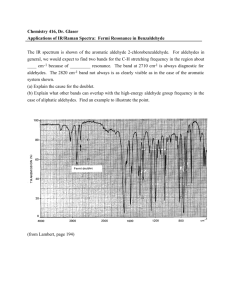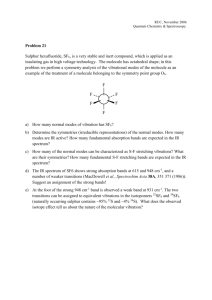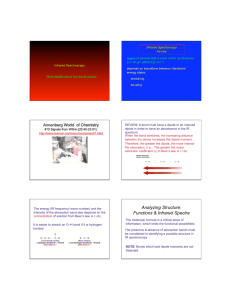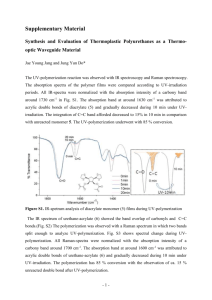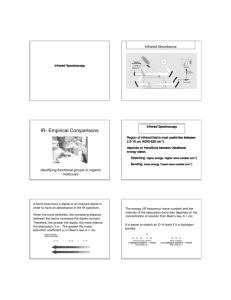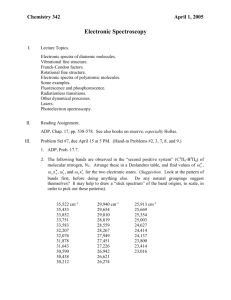Lecture 12 Power point notes
advertisement
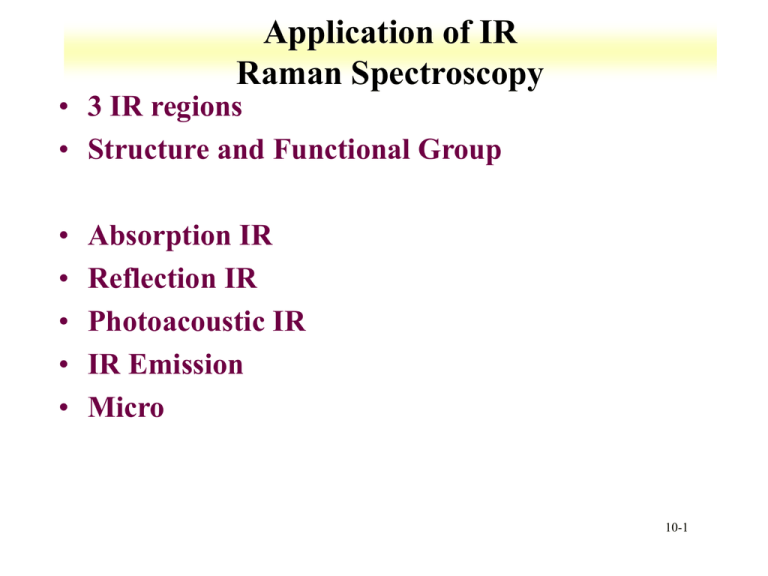
Application of IR Raman Spectroscopy • 3 IR regions • Structure and Functional Group • • • • • Absorption IR Reflection IR Photoacoustic IR IR Emission Micro 10-1 Mid-IR • Mid-IR absorption Samples Placed in cell (salt) Combined with oil Need cell that does not absorb IR KBr, NaCl * Tends to absorb water Gases Solutions Solvent issues * Dissolution of cell 10-2 Analysis • Can calculate group frequencies C-H, C=O, C=C, O-H Variations of frequencies for group • Fingerprint region Compare to standards Absorption of inorganics Sulphate, phosphate, nitrate, carbonate • Search spectra against library 10-3 Mid-IR 10-4 10-5 10-6 10-7 Interpretation • • • • • • Alcohols and amines display strong broad O-H and N-H stretching bands in the region 3400-3100 cm-1 bands are broadened due to hydrogen bonding and a sharp 'non-bonded' peak can around 3400 cm-1 . Alkene and alkyne C-H bonds display sharp stretching absorptions in the region 3100-3000 cm-1 bands are of medium intensity often obscured (i.e., OH). Triple bond stretching absorptions occur in the region 2400-2200 cm-1 Nitriles are generally of medium intensity and are clearly defined Alkynes absorb weakly unless they are highly asymmetric symmetrical alkynes do not show absorption bands Carbonyl stretching bands occur in the region 1800-1700 cm-1 bands are generally very strong and broad Carbonyl compounds (acyl halides, esters) are generally at higher wave number than simple ketones and aldehydes amides are the lowest, absorbing in the region 1700-1650 cm-1 Carbon-carbon double bond stretching occurs in the region around 1650-1600 cm-1 bands are generally sharp and of medium intensity Aromatic compounds will display a series of sharp bands Carbon-oxygen single bonds display stretching bands in the region 1200-1100 cm-1 bands are generally strong and broad 10-8 Quantitative IR • Difficult to obtain reliable quantitative data based on IR Deviations from Beer’s law Narrow Bands and wide slit widths required * Require calibration sources Complex spectra Weak beam Lack of reference cell Need to normalize refraction * Take reference and sample with same cell 10-9 Other methods • Reflectance IR Measurement of absorbance from reflected IR Surface measurement • Photoacoustic IR can use tunable laser • Near IR 700 nm to 2500 nm Quantitative analysis of samples * CH, NH, and OH Low absorption • Emission IR 10-10 Raman Spectroscopy • Scattering of light Fraction of scattered light in the visible differs from incident beam Difference based on molecular structure * Based on quantized vibrational changes * Difference between incident and scattered light is in mid-IR region No water interference Can examine aqueous samples Quartz or glass cells can be used Competition with fluorescence 10-11 Raman Spectroscopy • Theory • Instrumentation • Application • Method Excitation with UV or NIR Measurement of scatter at 90 ° Measurement 1E-5 of incident beam 10-12 Theory • 3 types of scattered radiation Stokes Lower energy than AntiStokes * Named from fluorescence behavior More intense Used for Raman measurements Anti-Stokes No fluorescence interference Rayleigh Most intense Same as incident radiation • Shift patterns independent of incident radiation wavelength 10-13 Theory • Excitation From ground or 1st vibrationally excited state Population of excited state from Boltzmann’s equation * Molecule populates virtual states with energy from photon * Can be effected by temperature Elastic scattering is Rayleigh Energy scattered=energy incident Energy difference due to ∆ ground and 1st excited state hn-DE is Stokes scattering Hn+DE is anti-Stokes scattering 10-14 10-15 Theory • Variation in polarizability of bond with length • Electric field (E) due to excitation frequency with E0 E E0 cos( 2nex t ) • Dipole moment (m) based on polarizability of bond (a) m aE aE0 cos( 2next ) • For Raman activity a must vary with distance a along bond a a 0 + (r - req )( ) r a0 is polarizability at req r - req rmax cos( 2nv t ) 10-16 Theory E0 a m a 0 E0 cos( 2nex t ) + rm ( ) cos( 2 (n ex -n n )t ) + 2 r E0 a rm ( ) cos( 2 (n ex +n n )t ) 2 r • Equation has Rayleigh, Stokes, and Anti-Stokes component • Complementary to IR absorbance Overlap not complete 10-17 10-18 Instrumentation • Laser source Ar (488 nm, 514.5 nm) Kr (530.9 nm, 647.1 nm) He/Ne (623 nm) Diode (782 nm or 830 nm) Nd/YAG (1064 nm) Tunable lasers Intensity proportional to n4 * Consider energy and chemical effect of absorbing energy 10-19 Instrumentation • Sample holder Glass Laser focusing allows small sample size Liquid and solid samples can be examined Use of fiber optics 10-20 Applications • Laser microprobes Use of laser permits small sampling area • Resonance Raman Use electronic absorption peak Low concentrations can be examined Lifetimes on 10 fs • Surface enhanced Raman Increase of sensitivity by 1000 to 1E6 10-21 10-22 10-23
